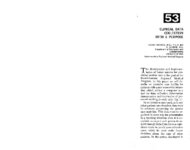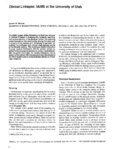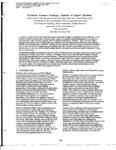Filters: Collection: "ir_uspace" Type: "Text" School Or College: "School of Medicine" Format: "application/pdf"
| Creator | Title | Description | Subject | Date | ||
|---|---|---|---|---|---|---|
| 151 |
 |
Olson, Randall J. | Clinical comparison of single-piece and three-piece truncated hydrophobic acrylic intraocular lenses | PURPOSE: To determine the clinical differences between three-piece (3P) and single-piece (SP) truncated hydrophobic acrylic intraocular lenses (IOL). DESIGN: Retrospective cohort clinical study. METHODS: The setting was an academic clinical practice. The patient population consisted of subjects with... | Lenses, Intraocular; Patient Satisfaction; Postoperative Complications; Prosthesis Design; Visual Acuity | 2003-10 |
| 152 |
 |
Warner, Homer R. | Clinical Data Collection With a Purpose | Biomedical Informatics | 1968 | |
| 153 |
 |
Olson, Randall J. | Clinical experience with 21-gauge manual microphacoemulsification using Sovereign WhiteStar Technology in eyes with dense cataract | PURPOSE: To present a series of patients who had 21-gauge microphacoemulsification using Sovereign WhiteStar technology. SETTING: John A. Moran Eye Center, University of Utah School of Medicine, Salt Lake City, Utah, USA. METHODS: Eighteen consecutive patients with cataracts judged to be 3+ or 4+ on... | Cataract; Microsurgery; Phacoemulsification; Postoperative Complications; Visual Acuity | 2004-01 |
| 154 |
 |
Warner, Homer R. | Clinical Linkages: IAIMS at the University of Utah | Biomedical Informatics | 1988 | |
| 155 |
 |
Del Fiol, Guilherme | Clinical questions raised by providers in the care of older adults: a prospective observational study | Objective: To characterise clinical questions raised by providers in the care of complex older adults in order to guide the design of interventions that can help providers answer these questions. Materials and methods: To elicit clinical questions, we observed and audio recorded outpatient visits at... | 2014-01-01 | |
| 156 |
 |
Baehr, Wolfgang | Cloning and molecular characterization of cGMP-gated ion channels from rod and cone photoreceptors of striped bass ( M. saxatilis ) retina | Vertebrate photoreceptors respond to light with changes in membrane conductance that reflect the activity of cyclic-nucleotide gated channels (CNG channels). The functional features of these channels differ in rods and cones; to understand the basis of these differences we cloned CNG channels from t... | Amino Acid Sequence; Computational Biology; Reverse Transcriptase Polymerase Chain Reaction | 2006 |
| 157 |
 |
Baehr, Wolfgang | Cloning and sequence analysis of the major outer membrane protein genes of two Chlamydia psittaci strains | We cloned and sequenced the gene encoding the major outer membrane protein (MOMP) of two Chlamydia psittaci strains, guinea pig inclusion conjunctivitis (GPIC) strain 1, and meningopneumonitis (Mn) strain Cal-10. Intraspecies alignment of the two C. psittaci MOMP genes revealed 80.6% similarity, and... | Base Sequence; Cloning, Molecular; Amino Acid Sequence | 1989 |
| 158 |
 |
Baehr, Wolfgang | Cloning of frog rod photoreceptor cGMP phosphodiesterase subunits (P-alpha, P-beta, P-gamma) and identification of P-gamma) sites involved in the stimulation of cGMP binding to P-alpha and P-beta non-catalytic sites | Retinal cGMP phosphodiesterase (PDE6) is a key enzyme in vertebrate phototransduction. Rod PDE contains two homologous catalytic subunits (Pd two identical regulatory subunits (P). Biochemical studies have shown that amphibian P has high affinity, cGMP-specific, non-catalytic binding sites and that ... | Phototransduction; Retinal cGMP phosphodiesterase; Amphibian PDE | 2002 |
| 159 |
 |
Warner, Homer R. | Clustered Disease Findings: Aspects of Experts Systems | Biomedical Informatics | 1989 | |
| 160 |
 |
Warner, Homer R. | Clustered Knowledge Representation: Increasing the Reliability of Computerized Expert Systems | Biomedical Informatics | 1988 | |
| 161 |
 |
Normann, Richard A.; Shoham, Shy | Coding of position by simultaneously recorded sensory neurones in the cat dorsal root ganglion | Muscle, cutaneous and joint afferents continuously signal information about the position and movement of individual joints. How does the nervous system extract more global information, for example about the position of the foot in space? To study this question we used microelectrode arrays to record... | Cats; Sensory Neurones; Movement; Limb Position | 2004 |
| 162 |
 |
Olson, Randall J. | Cohort study of 27 cases of endophthalmitis at a single institution | PURPOSE: To identify potential risk factors associated with post-cataract surgery bacterial endophthalmitis. SETTING: The John A. Moran Eye Center, Salt Lake City, Utah, USA. METHODS: This retrospective cohort study consisted of patients who had surgery for cataract(s) at this eye hospital. A 10% sa... | Cataract Extraction; Endophthalmitis; Wound Healing; Risk Factors | 2005-04 |
| 163 |
 |
Mitchell, Joyce A. | The columbia registry of controlled clinical computer trials | Numerous reports on randomized controlled clinical trials of comnputer-based interventions have been published. These trials provide useful evaluations of the impact of information technology on patient care. Unfortunately, several obstacles make access to the trial reports difficult. Barriers inclu... | 1992-01-01 | |
| 164 |
 |
Couldwell, William T. | Combined transmastoid retro- and infralabyrinthine transjugular transcondylar transtubercular high cervical approach for resection of glomus jugulare tumors | COMPLEX TUMORS OF the glomus jugulare present a surgical challenge because of their difficult location, extreme vascularity, and involvement with multiple cranial nerves. Modern microneurosurgical and cranial base techniques have enabled safe total removal of these complicated tumors. We describe a ... | Cranial base approach; Surgical approach; Glomus jugulare tumor; Jugular foramen exposure; Microsurgical anatomy | 2006 |
| 165 |
 |
Couldwell, William T. | Comment on Aydin, K., et al: Localization of cerebrospinal fliud leaks by gadolinium-enhanced magnetic resonance cisternography: a 5-year single-center experience | The Author's describe the use of intrathecal Gd-enhanced MR cisternography for the definition of cerebrospinal fluid leaks in 51 patients. They were able to identify the site of leak in 43 of 51 patients (84%). Although the technique is not new, most of the previous articles are found in the neuror... | Cerebrospinal fluid leaks | 2007 |
| 166 |
 |
Couldwell, William T. | Comment on Kitano, M. and Taneda, M.: Extended transsphenoidal approach to the anterior communicating artery aneurysm: aneurysm incidentally identified during macroadenoma resection | Kitano and Taneda describe the successful clipping of an ACoA aneurysm via the transsphenoidal approach. There are limitations of the approach; most notable are the limited and narrow corridor and the relationship between the aneurysm and the optic chiasm, which may hinder full visualization of the ... | Aneurysm; Transsphenoidal approach | 2007 |
| 167 |
 |
Couldwell, William T. | Comment on Kitano, M., et al.: Subdural patch graft technique for watertight closure of large dural defects in extended transsphenoidal surgery | Ahn and Kim demonstrate a suturing technique to close dural defects after transsphenoidal and extended transsphenoidal approaches. The technique entails a specifically designed forceps to cinch the knot down in the depths of the field. The Author's used the technique in 21 consecutive patients (16 e... | Transsphenoidal surgery; CSF leaks | 2009 |
| 168 |
 |
Couldwell, William T. | Comment on Nugent, G. R.: Targeting the ventral lateral nucleus of the thalamus: a stereotactic vignette | Dr. Nugent provides a fascinating personal account of his early experience with stereotactic surgery for movement disorders. I was especially pleased to read the positive comments regarding the personal interactions with and innovations of Irving Cooper, a neurosurgeon who was derided by his peers b... | Stereotactic surgery; Stereotaxis | 2006 |
| 169 |
 |
Couldwell, William T. | Comment on Wong, H. T., et al.: Comparative impact of video consultation on emergency neurosurgical referrals | The Author's explored the facility and accuracy of telephone, teleradiology, or video consultation between a large general hospital and their tertiary neurosurgical center. Although there was increased diagnostic accuracy with video consultation or teleradiology, they note that consultation via vid... | Teleradiology; Video consultation; Neurosurgical referrals | 2006 |
| 170 |
 |
Couldwell, William T. | Comment on: Chronic brain inflammation and persistent herpes simplex virus 1 thymidine kinase expression in survivors of syngeneic glioma treated by adenovirus-mediated gene therapy: implications for clinical trials | The long-term consequences of adenovirus-mediated conditional cytotoxic gene therapy for gliomas remain uncharacterized. We report here detection of active brain inflammation 3 months after successful inhibition of syngeneic glioma growth. The inflammatory infiltrate consisted of activated macrophag... | Brain inflammation; Herpes simplex virus-1; Thymidine kinase; Syngeneic glioma; Adenovirus-mediated gene therapy | 1994 |
| 171 |
 |
Couldwell, William T. | Communication between malignant glioma cells and vascular endothelial cells through gap junctions | Object. Extensive invasion and angiogenesis are hallmark features of malignant gliomas. Communication between malignant glioma cells and surrounding astrocytes occurs, resulting in transformation of the astrocytic phenotype. In the present study, the authors examined whether malignant glioma cells a... | 2003-01-01 | |
| 172 |
 |
Gesteland, Raymond F.; Wills, Norma M.; Atkins, John F. | Comparative studies of frameshifting and nonframeshifting RNA pseudoknots: a mutational and NMR investigation of pseudoknots derived from the bacteriophage T2 gene 32 mRNA and the retroviral gag-pro frameshift site | Mutational and NMR methods were used to investigate features of sequence, structure, and dynamics that are associated with the ability of a pseudoknot to stimulate a "1 frameshift. In vitro frameshift assays were performed on retroviral gag-pro frameshift-stimulating pseudoknots and their derivati... | Frameshifting; NMR; Pseudoknot; Retrovirus | 2002 |
| 173 |
 |
Kestle, John R. W. | Comparison between magnetic resonance imaging and computed tomography for stereotactic coordinate determination | The spatial accuracy of magnetic resonance imaging (MRI) has not been established for stereotactic surgery. Magnetic susceptibility artifacts may lead to anatomical distortion and inaccurate stereotactic MRI coordinates, especially when targets are in regions of the brain out of the center of the ma... | Computed tomography; Stereotactic coordinates; Stereotactic surgery | 1992 |
| 174 |
 |
Dailey, Andrew T.; Brodke, Darrel S. | Comparison of computerized tomography and direct visualization in thoracic pedicle screw placement | Object. To validate computerized tomography (CT) scanning as a tool to assess the accuracy of thoracic pedicle screw placement, the authors compared its accuracy with that of direct visualization in instrumented cadaveric spine specimens. Methods. A grading scale was devised to score the placement... | Computerized tomography; Direct visualization; Thoracic pedicle screw; Pedicle; Thoracic spine | 2002 |
| 175 |
 |
Warner, Homer R. | Comparison of Different Information Content Models by Using Two Strategies: Development of the Best Information Algorithm for Iliad | Biomedical Informatics | 1992 |
